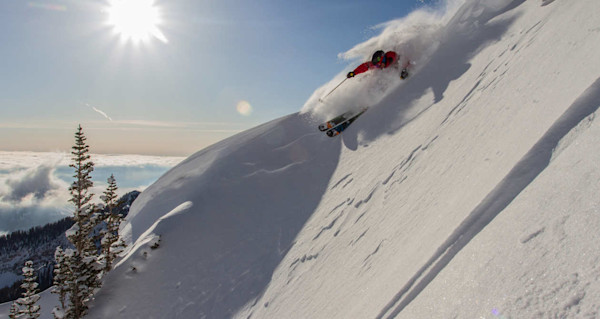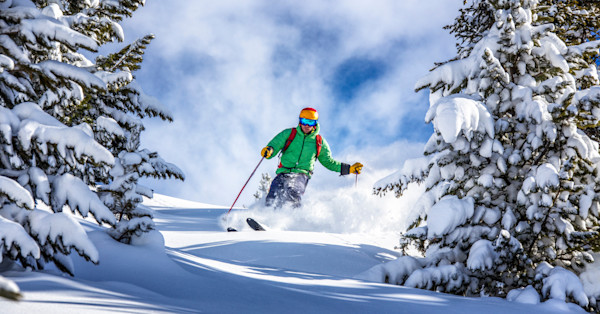
Get Ready for Skiing in Utah
Scout the terrain, book your trip — and maybe spend some time at the gym.
You know climbing a mountain is a workout. That’s a given. But skiing down one? Yep, it can leave you sucking wind, too. And while the sparkly white beauty may leave you breathless, we don’t want you to be literally gasping. Get prepared for Utah’s extreme — and totally rad — terrain with our tips and tricks for living your best ski life.
You Got Skillz?
We have 15 resorts sprinkled across the state, which means you have mountains of choices when it comes to deciding where to ski in Utah. What are your plans? Snowboarding? Skiing? Black diamonding? Or maybe just pizza or french fries.
Pick the resort with the types of runs you’re chasing. And if you’re wondering what fast food has to do with skiing, we suggest taking some onsite ski lessons before hopping over to the bunny hill.
What’s Your Type?
If you prefer to ski as people did in the ‘80s — sans snowboarders — try Alta or Deer Valley, which allow traditional skiing only. Snowboarders are welcome at all the other resorts. If you have non-skiers in the group, Woodward Park City offers other extreme sports for them to try.
All By Yourself
If you want to avoid crowds, maybe skip the hills up Big and Little Cottonwood Canyons — Alta, Brighton, Snowbird and Solitude. Wait, what is Solitude? Yeah, maybe not the best name for a bustling place. Instead, try Beaver Mountain or Cherry Peak in Cache County. And if you really want to be alone, head to Eagle Point Resort in Beaver.
Seize the Right Day
Another way to avoid crowds? Choose the right day. The resorts — and the roads leading up to them — are nearly always full on weekends and holidays. Plan your slope time during the middle of the week if you’d like more terrain to yourself, and shorter lift lines. If weekends are your only option, try going later in the day; crowds tend to thin out after 1 p.m.
… And Month
You can often plan a ski vacation as early as November, thanks to the machine-made snow, and the crowds are fairly mild before the holidays. Late January and February tend to have the best snow conditions, with a solid base and fresh powder. If you prefer temperatures to be a bit warmer, come in the spring season. There’s usually still plenty of snow, and often ski deals.
Get Fit
Are you dressed to slay, uh, play? You’ll need the right clothes and gear if you don’t want to be literally chillin’ in your boots. Wear a waterproof coat, snow pants, gloves, sunglasses and a beanie. It’s a good idea to dress in layers: Temperatures can change quickly.
If you don’t have your own ski equipment — helmet, boots, skis/snowboard, poles — there are several rental companies in Utah that can get you outfitted.
You should be up to the sport physically, too, of course. Those thighs and glutes are gonna burn if you’re not prepped. For daaays. So practice your squats and lunges before booking your trip. Work on your core, too. You don’t have to get shredded to shred, per se, but strong abs will help you stay balanced while standing on those two thin, slick boards.
Acclimatize Every Mountain
Salt Lake City’s elevation is about 4,200 feet, and once you head up into the mountains it gets, well, even higher. Alta, Snowbird and Brian Head ski resorts are each near 11,000 feet, high enough to cause anyone to feel a bit of altitude sickness. And a headache and nausea can kinda put a damper on your ski day.
If you can, enjoy some less physically intensive winter activities for a few days at the higher elevation, giving your body a chance to acclimatize. In the meantime, keep yourself well hydrated in the drier air. It’s also helpful to avoid alcohol for the first 48 hours above 8,000 feet. If you’re coming from near sea level, consider spending the day on the mountain, but returning to the city for sleep.
Hitch a Ride
All roads lead to Rome, but only one leads to each resort, which means two things: There’s going to be a lot of traffic, and it’s nearly impossible to find a parking space. Public transit to the rescue! Take the UTA Ski Bus and leave the driving worries to the people who get paid to deal with it. It’s about $5 per ride — probably less than the gas you’d burn idling. And it’s much safer when you take that catnap on the way home.
If you want to try it yourself, be sure you’re prepared to drive in the snow. It can get a little dicey on those mountain roads, particularly where the road is shaded and during snowstorms.
Know the Way
Once you get to the resort, the mountain can look overwhelming. Which run(s) should you try? Which lift will get you there? Before you go, study up on resort maps and read recommendations to get an idea of where you’d like to ski. If you’re unfamiliar with the resort, it’s especially important to stick to groomed trails so you don’t get lost.
Eat It!
After a full day — or even a half — on the slopes, you’ll probably be feeling peckish — if not downright ravenous. Just how many calories do you burn skiing, anyway? Definitely enough to justify a nice dinner afterward. Skiing really is a workout, so bring a sandwich for lunch and pack some healthy snacks to keep your energy up until dinner time. Be sure to properly dispose of all your trash to keep the mountains beautiful for everyone.
Call it a day and get some rest, because tomorrow is calling. It says you should try a winter hike next. Then maybe a bit of snowshoeing. Ice skating, anyone?
Categories:
You May Also Like
View All12 Must-Ski Runs in Salt Lake City
Salt Lake City's four world-class ski resorts are just 20-30 minutes from downtown and 30-40 minutes...
Where is (Blank) Ski Resort in Utah?
S’nobody knows snow like Utah. Ski it up close and personal at one of the 15 resorts near you. Face ...

